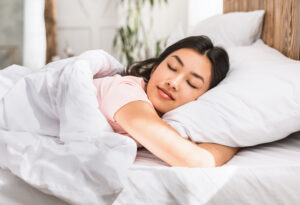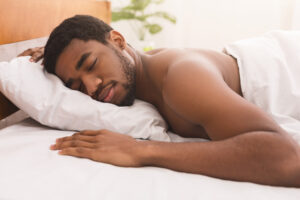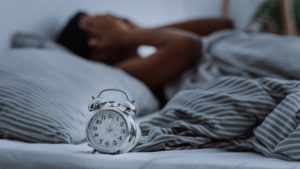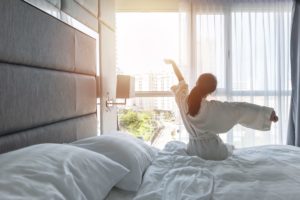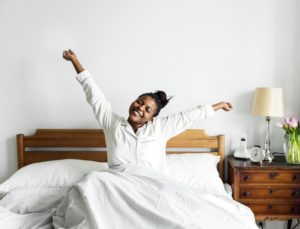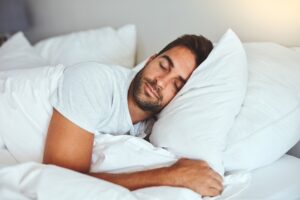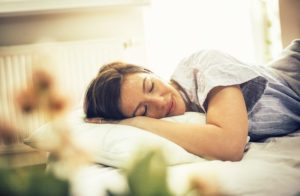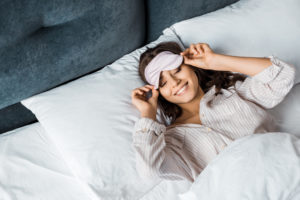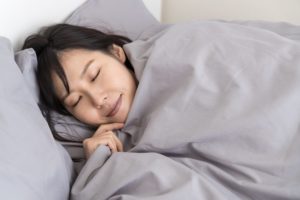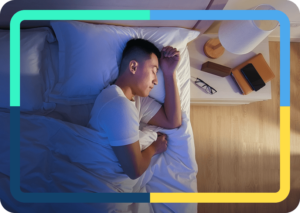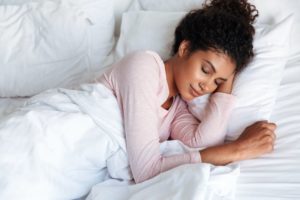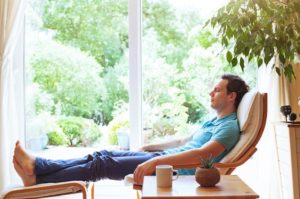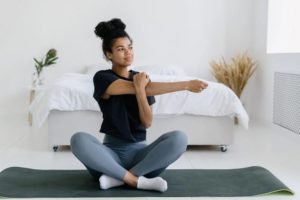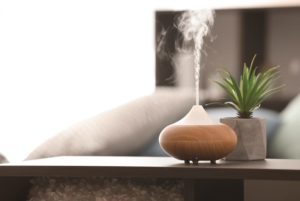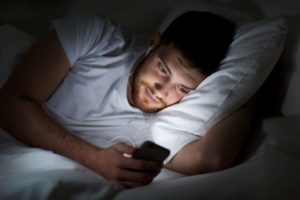When you buy through our links, we may earn a commission. Products or services may be offered by an affiliated entity. Learn more.
What Is a Sleep Divorce?
At first glance, the term “sleep divorce” might appear to imply relationship troubles. In actuality, it’s a practice more people are engaging in to improve their sleep and relationships. A sleep divorce refers to romantic partners sleeping in different rooms rather than sharing a bed at night.
We explore reasons couples initiate a sleep divorce, pros and cons of sleeping in different rooms, and when it’s time to consider sleep divorcing.
Struggling to Stay Awake? Take an At-Home Sleep Test

our partner at sleepdoctor.com
10% off Home Sleep Tests
Buy Now“Truly grateful for this home sleep test. Fair pricing and improved my sleep!”
Dawn G. – Verified Tester
Bed Share vs. Sleep Divorce: Why Make the Change?
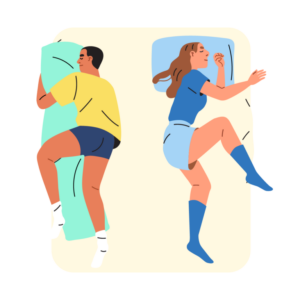
The idea of a sleep divorce has recently gained in popularity, with one survey finding that over one-third of people regularly sleep in a different room from their romantic partner. Many news outlets have covered the concept, since celebrities including actor Cameron Diaz and television host Carson Daly have publicly discussed sleeping separately from their spouses.
According to a SleepFoundation.org survey, couples who choose to sleep in different rooms do so for a variety of reasons. Some who sleep separately from their partner find they benefit from it. Others end up eventually sleeping in the same bed once again. The pros and cons of a sleep divorce likely differ from situation to situation.
Pros of a Sleep Divorce
Many people who experiment with a sleep divorce experience benefits.
- Reduced sleep interruptions: Many people choose to sleep separately so as to reduce sleep interruptions. When partners sleep in the same bed, they may disturb each other’s sleep due to different sleep schedules, the need to get up to parent, snoring, leg movements, sleep-related behaviors, or awakenings caused by pregnancy or illnesses, like seasonal allergies.
- Improved sleep quality: By avoiding disruptions caused by a bed partner, about 53% of people who have tried a sleep divorce report that their sleep quality increased after sleeping alone.
- Increased time asleep: Similarly, those who stick with a sleep divorce over time report that they sleep an average of 37 minutes more each night while sleeping separately.
- Improved relationship: If sleeping separately improves a couples’ sleep, it may also improve their relationship as a result. When both members of a couple fall short on sleep, they may treat each other with more hostility . Experiencing poor sleep is also tied to increased anger and the perception of having a lower quality relationship.
- Safety: When someone experiences dream-enactment behaviors, as may occur in REM sleep behavior disorder, it may be best to sleep alone to prevent injuries. Hitting, kicking, and other sudden, violent actions may cause serious injury. In some cases, it is important for bed partners to sleep apart to avoid accidental harm.
Cons of a Sleep Divorce
Although many couples benefit from a sleep divorce, there are potential drawbacks.
- Increased cost: Perhaps the most obvious drawback of a sleep divorce is that it requires two available rooms to sleep in instead of one. While that is likely no problem for the high-paid celebrities promoting the practice, not everyone else has an extra bedroom and high-quality bed to spare in their home.
- Reduced intimacy: Over one-fourth of couples who try out a sleep divorce end up eventually sharing a bed again later. For over one-third of them, missing each other was what brought them back together. If you’re accustomed to cuddling up with your partner at night, suddenly sleeping alone might feel lonely. This may also have an impact on the couple’s sex life.
- Worsened sleep quality: Although sleeping separately improves sleep quality for some, it reduces sleep quality for others. Of people who tried a sleep divorce, then eventually began sleeping together again, 40% say their sleep quality improved after ending the sleep divorce. Also, one research study found that sleeping with a romantic partner was associated with both better sleep quality and better mental health.
- Security: For some people, sleeping alone may affect their sense of security. This can lead to lighter sleep as they remain in surveillance mode, listening for safety threats within the sleep environment. When a bed partner is present, this may provide reassurance and reduce insomnia.
When It’s Time to Bring Up a Sleep Divorce…

If sleeping with your partner is significantly interfering with your sleep, it might be time to discuss a sleep divorce. Regularly falling short on sleep comes with many risks. A person who isn’t sleeping long enough or whose sleep is regularly interrupted has a lower quality of life, is more prone to car crashes and work errors, faces a higher risk of heart problems, develops a weaker immune system, and may be more likely to gain weight and develop a slower metabolism.
That said, before trying a sleep divorce, you may want to consider other options.
Alternatives to a Sleep Divorce
A sleep divorce may be a big commitment, especially if it involves rearranging your home or buying a new bed. First, you might want to try other alternatives.
- Screening for sleep apnea: If snoring is motivating you to try a sleep divorce, screening for sleep apnea could be in order. Commonly, snoring is a symptom of the disorder. Other signs of sleep apnea include gasping or pausing breathing during sleep, feeling tired during the day, waking up at night to urinate, irritability, and a tendency to fall asleep while driving or watching television.
- Changing sleep schedules: If different sleep schedules are the issue, making adjustments may help you avoid a sleep divorce. For example, if one person prefers to stay up late, they could train themselves to go to sleep at an earlier time, so as to avoid waking up their partner. Of course, sometimes external factors, like work schedules, make sleep schedule adjustments difficult or impossible.
- Using other sleep-promoting tools: When sleeping in a different room isn’t ideal, there are other ways to potentially shut out disturbances caused by a sleep partner. One survey found that 18% of sleepers wear an eye mask to block out light and 15% use earplugs to block out sound in order to sleep with their partner more easily.
- Sleep Scandinavian style: The Scandinavian style of sleeping involves sharing the same bed, but not the same bedding. This option allows each partner to use the type of bedding that best suits their nighttime temperature preferences. It also allows for more freedom of movement that’s less likely to disturb a bed partner.

Still have questions? Ask our community!
Join our Sleep Care Community — a trusted hub of sleep health professionals, product specialists, and people just like you. Whether you need expert sleep advice for your insomnia or you’re searching for the perfect mattress, we’ve got you covered. Get personalized guidance from the experts who know sleep best.
References
4 Sources
-
American Academy of Sleep Medicine. (2023, July 10). Over a third of Americans opt for a “sleep divorce”.
https://aasm.org/over-a-third-americans-opt-sleep-divorce/ -
Wilson, S. J., Jaremka, L. M., Fagundes, C. P., Andridge, R., Peng, J., Malarkey, W. B., Habash, D., Belury, M. A., & Kiecolt-Glaser, J. K. (2017). Shortened sleep fuels inflammatory responses to marital conflict: Emotion regulation matters. Psychoneuroendocrinology, 79, 74–83.
https://pubmed.ncbi.nlm.nih.gov/28262602/ -
Audigier, A., Glass, S., Slotter, E. B., & Pantesco, E. (2023). Tired, angry, and unhappy with us: Poor sleep quality predicts increased anger and worsened perceptions of relationship quality. Journal of Social and Personal Relationships, 40(12), 3803-3831.
https://journals.sagepub.com/doi/abs/10.1177/02654075231193449 -
Brandon Fuentes, Kathryn Kennedy, William Killgore, Chloe Wills, Michael Grandner, 0010 Bed Sharing Versus Sleeping Alone Associated with Sleep Health and Mental Health, Sleep, Volume 45, Issue Supplement_1, June 2022, Page A4.
https://academic.oup.com/sleep/article/45/Supplement_1/A4/6592562




